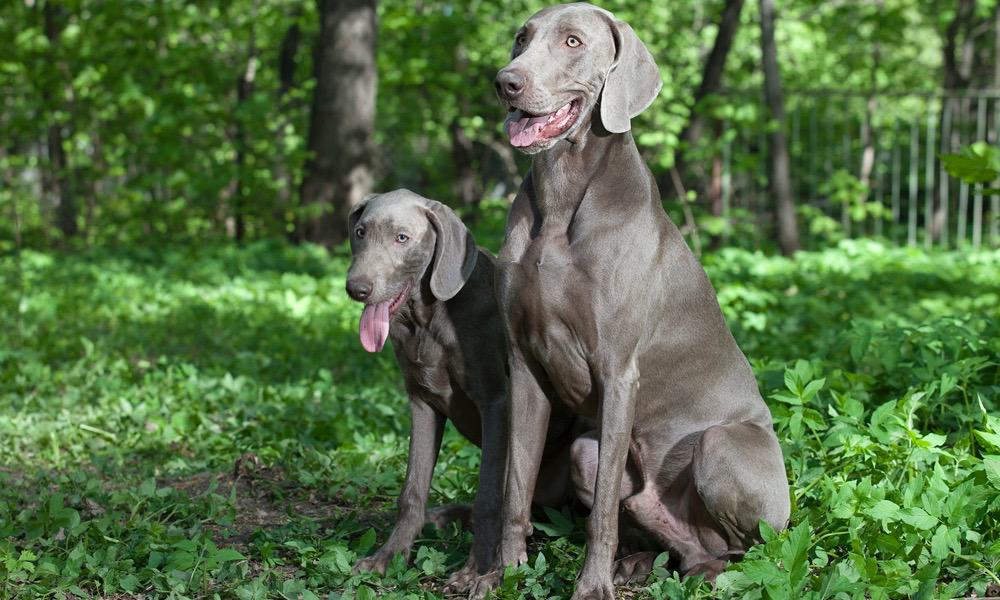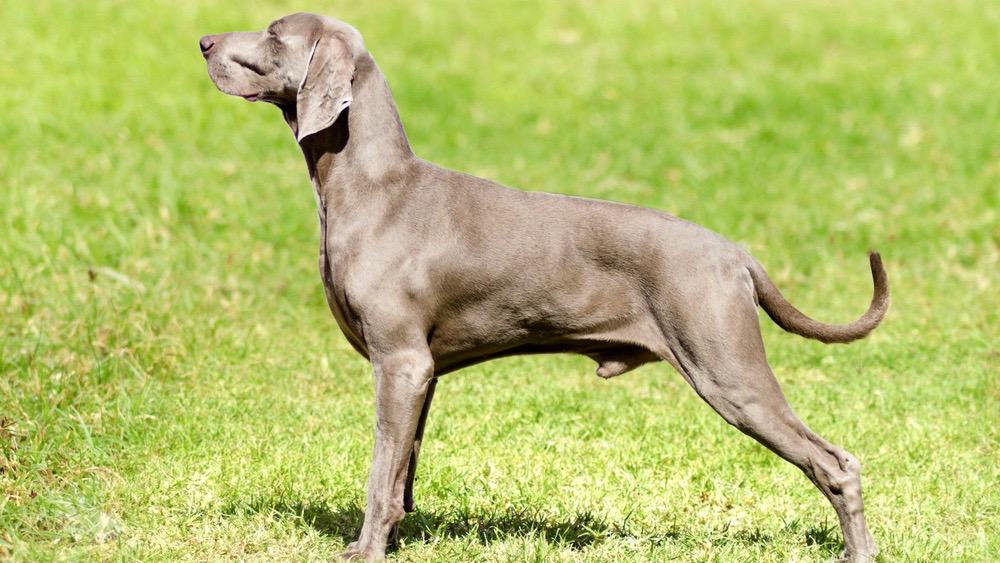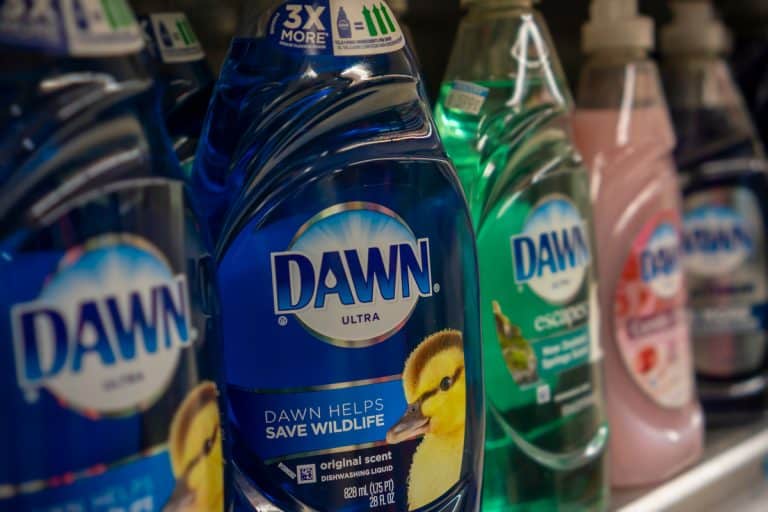Weimaraner Growth Chart (Weight Chart) – When Do Weimaraners Stop Growing
The Weimaraner was formerly bred as a gun dog in Germany and is an excellent hunting companion. Also known as the ‘silver ghost’, these dogs are highly energetic and playful.
They require plenty of physical activity every day. The Weimaraner breed gets along with family and friends very well, but they don’t like to be alone for long periods.
Some of the most prominent features of the Weimaraner are its exceptional speed and endurance. They combine grace, stamina, and an alert demeanor to make well-rounded comrades throughout their lives.
They have excellent distinguished features, with kind, friendly expressions. Their short smooth coat is easy to maintain.
We’ve formulated a Weimaraner growth chart to help you keep track of his growth.
When Do Weimaraners Stop Growing

Usually, a Weimaraner reaches adulthood between 1 and 2 years of age. For most dogs, full sized growth comes within the first year.
During the second year, the dog will continue to develop muscles and other bodily functions.
Some Weimaraners actually reach their full size between 6 months and a year. It’s important to note that this can vary depending on your dog’s nutrition, exercise level, and genetics.
To ensure that your dog is developing properly you should provide him with proper nutrition and spend a bit of time with him inauspicious area so that he can exercise. Spending time with your dog also adds to his overall well-being, and he will love you for it.
Weimaraner Weight Chart
The Weimaraner weight chart below displays the relative size of your Weimaraner’s and weight throughout the stages of development. If your dog’s weight is not exactly the same as the chart, there is usually no need for alarm as every dog is different.
But, it should be noted that if you find your Weimaraner’s weight is considerably less than on the Weimaraner chart, you need to take an appraisal of his overall health and wellbeing.
It could be that your Weimaraner is too thin and may have a greater chance of having several health-related issues.
You should not think about it too much if your Weimaraner’s weight is greater than any of the numbers in the chart. If he has a few extra pounds over the normal range it is perfectly acceptable, not all Weimaraners may fall within the stated range.
The important thing is that you always check with your veterinarian whenever you have doubts.
You can use this Weimaraner weight chart as a frame of reference, but understand that the numbers won’t be applicable for every dog. Because you spend the most time with your dog, you may have a clearer idea about his overall health.
Weimaraner Puppy Weight Chart
| Age | Average Weight in lbs | Average Weight in kg |
|---|---|---|
| 8 Weeks | 12.6 lbs | 5.7 kg |
| 10 Weeks | 17 lbs | 7.7 kg |
| 11 Weeks | 18 lbs | 8.2 kg |
| 3 Months | 21 lbs | 9.5 kg |
| 3.5 Months | 28 lbs | 12.7 kg |
| 4 Months | 36 lbs | 16.3 kg |
| 5 months | 39 lbs | 17.7 kg |
| 6 months | 48 lbs | 21.8 kg |
| 7 months | 54 lbs | 24.5 kg |
| 8 months | 59 lbs | 26.8 kg |
| 9 Months | 68 lbs | 30.8 kg |
| 10 Months | 72 lbs | 32.7 kg |
| 11 Months | 73 lbs | 33.1 kg |
| 12 Months | 74 lbs | 33.5 kg |
Weimaraner Growth Chart – What To Expect
Birth – 2 Weeks
When your Weimaraner puppies are at this stage, they are underdeveloped and are in need of their mother’s warmth and nourishment.
They can’t yet hear or see but the senses of touch, smell, and taste are there. They will be sleeping and nursing most of the time as they develop their strength. Furthermore, they can’t walk yet because of their undeveloped muscles.
Weimaraner puppies are the only dog breed that has lengthwise stripes when they are born. These fade away in the first two weeks after their birth. This initial piece of their development is very important.
3 Weeks – 12 Weeks
During this period, your Weimaraner will open his eyes and begin to use his sense of hearing. His teeth will start to develop, and he will grow muscles strong enough to stand up, play with his littermates, run, and bark.
He will slowly start to be knowledgeable of his environment as his eyesight improves as well as get control over his bowel movement and bladder. His muscle coordination will also increase as he runs, plays, and explores.
4 Months – 6 Months
At this time, your puppy’s adult teeth begin to form, and he will want to sharpen his teeth, therefore you should invest in some chew toys, then he won’t chew important things he finds.
You are now the main influencer of the puppy, and quality time is necessary to create a strong bond.

7 Months – 12 Months
During this phase, your Weimaraner will come to sexual maturity and undergo drastic hormonal shifts, which happen a bit differently in male and female dogs.
The female dogs that are going through sexual maturity customarily enter their heat cycle around twice per year and lasts for 2-3 weeks. In contrast, male dogs are sexually active all throughout the year.
Adult
Weimaraners will reach adulthood when they are around one year old. At this age, they usually attain most of their development and are still very active, although they may be less playful.
They still require adequate nutrition so that they will have healthy bones and muscles. Physical activity will also help to achieve this.

Factors That Affect Weimaraner Puppy Growth
Genetics
Hereditary traits have a prominent influence on a Weimaraner’s growth. These biological factors set the rate of growth as well as other important factors which contribute to their advancement.
The parents of your dog play an essential role in your dog’s present physical health because those genes are transferred down and affect your dog’s ability to grow as well as his propensity to specific illnesses.
Nutrition
Your dog’s nutrition affects growth as well as his overall quality of life. The food you feed your Weimaraner puppy will affect his ability to grow.
His growth will be impeded if you consistently provide your dog with low-quality food that doesn’t contain the proper vitamins and minerals he needs to develop.
Many dog-parents attempt to give their dogs the best foods for sale on the market because there are many foods of low quality that fail to offer nutrients.
Physical Activity & Health
Weimaraners are great hunters so they enjoy being active. They tend to be bored and make mischief in the house if they do not get sufficient exercise.
Physical activity is required so that growth and bone density can occur. With a daily schedule, your puppy will grow naturally and meet his developmental milestones.
He will have a fitter body that will add weight to your puppy while keeping him healthy. Your Weimaraner will also have an improved mood and overall well-being if allowed to engage in regular physical activity.
How Long Are Weimaraners Pregnant?
Usually, female Weimaraners spend around 63 days in pregnancy after they are bred. Nevertheless, any period between 54 and 72 days is the norm.
Most dog breeds are okay without human help; in contrast, some breeds need much more attention and examination.

To have a healthy dog, the female should wait at least one and a half to two years between each litter to get pregnant again. This ensures that the female is in good health and can physically handle a pregnancy.
If you believe your dog is pregnant, you should take her to a veterinarian who will be able to confirm this for you. For most dog parents it is usually difficult to ascertain the definite date of conception.
How Many Puppies Do Weimaraners Have?
Usually, has a Weimaraner litter of between six and eight pups with an average number of seven. This is the common litter size for many breeds of dogs.
Hardly ever will the Weimaraner have more than 10 puppies in a litter. You should also remember that healthier dogs will be able to produce more puppies.
There are particular times of the year when litters are rare, but during the summer and autumn months, there are usually many.
What Is The Life Expectancy Of Weimaraners?
The average Weimaraner has a life expectancy of 11 to 12 years. However, there have been documented Weimaraners that survive up to their teens. Dog parents who are committed to health and wellness and would most likely raise these dogs.
Maintaining a healthy weight via diet and exercise is perhaps the surest ways to extend a Weimaraner’s lifespan. The longest surviving Weimaraner lived to 18 years and 10 months old.

Deep-chested dog breeds like the Weimaraner are also at risk for bloat. It places pressure on the organs and can be detrimental to health. Remember to ensure that your dog regularly visits the vet.
How Much Does It Cost To Own A Weimaraner?
It typically costs is about $500 to $1,200, annually to own a Weimaraner, with the average cost at about $700. This would cover all the expenses such as food, training, vet visits, toys, and vaccinations.
The quantity, as well as the quality of food that you intend to purchase, will determine the overall budget you need to feed your Weimaraner. Also, the food expenses will be different based on the age, size, and physical activity of your dog.
The average cost of owning a Weimaraner is $22,705 in his lifetime. This will be enough to take care of all his needs like medical expenses, training costs, food supplies, licenses, grooming expenses, and a microchip if you need one.
Weimaraner Genetics And Common Health Problems
The Weimaraner is predisposed to having numerous conditions such as gastric torsion, spinal dysraphism, and skin tumors.
Gastric Torsion – Giant and large breeds usually have a problem with Gastric torsion It also exists in some medium-sized breeds like the Weimaraner. It occurs when dogs overfill their stomach with food or liquid, and especially if they subsequently exercise. This has an adverse effect on the organs.
Spinal Dysraphism – Spinal dysraphism refers to various kinds of problems that happen in the spine. These issues can impact the dog’s health in various ways.
Skin Tumors – Weimaraner dogs have a higher likelihood of developing certain types of skin tumors. Immediately visit the vet for a check-up, if you notice any lumps in your dog’s skin.







